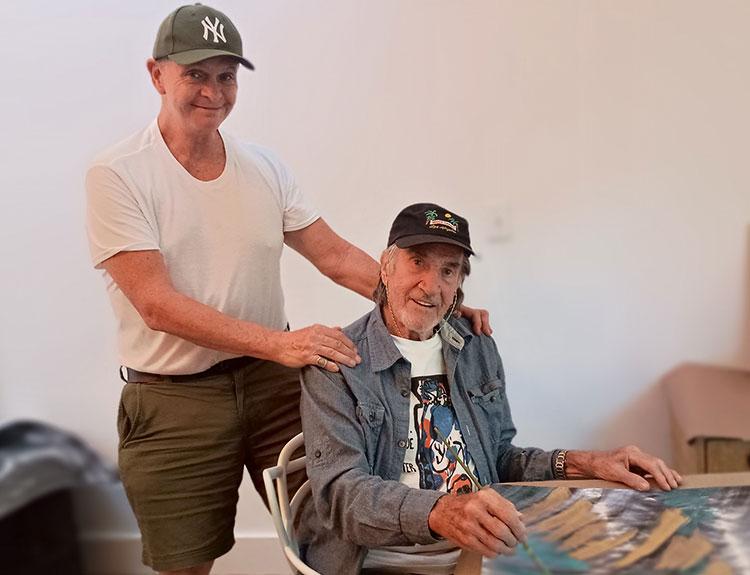Warren Strugatch, a writer and “semi-retired” journalist based in Stony Brook, first met the Dutch-born sculptor Hans Van de Bovenkamp in the spring of 2018. He had been invited out to Twin Oaks Farm, the artist’s seven-acre property in Sagaponack, to interview him for “Show Us Your Wall” — a New York Times arts column that profiled art collectors through interviews conducted in their living spaces. The conversation they started that day picked up again after the piece was published.
“I think he was very pleased to hear from a lot of old friends he had lost touch with, who rang him up after that column ran, and he invited me over,” Mr. Strugatch said, during a phone call last week. “And, I mean, people say that all the time, but usually once the article is published everybody moves on to the next thing — but Hans was good for his word.”
They met for lunch, and Mr. Van de Bovenkamp, who was 79 at the time, raised the idea of collaborating on a book about his life. Nothing came of it at the time, but the two stayed in touch, meeting once or twice a year for social visits, and in May of this year Mr. Strugatch brought up the idea again.
“About three years ago I lost my wife, Cindy,” he explained. She had accompanied him on many trips to Sagaponack, and she “never really forgot Hans. She thought he was a special person, and he is, and before she died she suggested that I write that book after all.” Mr. Van de Bovenkamp was amenable, and asked whether the book could be done in time for Authors Night at the East Hampton Library on Aug. 9.
A “tight” turnaround on a memoir would usually be between six and nine months, in Mr. Strugatch’s estimation, but he committed to the deadline and pushed to begin his customary 10-day “writer’s residency” at the artist’s property as soon as possible. He moved into Mr. Van de Bovenkamp’s studio in mid-June, and the first printing of “Sculpting My Life: Memoirs of a Crazy Dutch Artist” was ready for pickup from the printer on Aug. 7.
“The stories in the book are all Hans. My job was really to kind of mine the stories, sift through them, and find the themes,” Mr. Strugatch said. They spoke for a few hours each morning, and again in the evening, and for the rest of the day Mr. Strugatch had access to decades of the artist’s personal letters and photographs (and to his “immaculate” swimming pool). He had worked on other people’s memoirs before, in some cases without upfront credit, but Mr. Van de Bovenkamp had made it clear he wanted Mr. Strugatch to be a collaborator, “reflecting the experience” of their conversations.
“When I was starting out in journalism I thought, ‘Well, I’m the interviewer, that means I ask questions.’ And that’s fine, but as time went on I had much more ownership of the interviews — more like a curator, I think is the term. And that’s something that has evolved, and I think continued to evolve,” he said. He types his interviews out contemporaneously, rather than relying on audio recordings, which he says allows him to “really focus” on the conversation.
“It’s almost like a jazz duo,” he said. “And instead of feeding chords to the bass player, I’m feeding questions to the interviewee. And it’s an interactive process. I’m listening to Hans’s stories, and I’m also shaping them by saying, you know, what’s the next question?”
The memoir is written in a conversational first-person, a voice Mr. Strugatch developed over the course of their collaboration. “These were not necessarily sentences that Hans said to me,” he said. “You know, in the early stories I try to recreate his voice as a child, as a teenager, as the new kid on the block on East 10th Street — that kind of thing. And the epilogue is Hans today, looking back and really making sense of the arc of his life.”
Mr. Strugatch returned to Sagaponack in July for a final week of writing and revisions, and he sent the final work off to an “incredibly reliable” printer in Queens on Aug. 1. The books were ready for pickup a week later, and he loaded the box of them into his Miata and drove them out to East Hampton the day before Authors Night, making the deadline “by the skin of [his] teeth.”
“The book sold out, which was very rewarding. Obviously, people were coming to congratulate Hans and to buy Hans’s book. I didn’t think that they were coming because I was sitting there, you know — I’m not that crazy. But for me the gratification was helping Hans tell his story so that he could sign copies of the book.”
The process has inspired Mr. Strugatch to create his own publishing company, Character Arc Publishing, which he is in the process of forming. It will specialize in collaborations like the one he undertook with Mr. Van de Bovenkamp, and he plans to print a second run of the book under that name.
“Probably the clearest quality that I think I want to emphasize with you, and maybe the difference between collaborating on a memoir and writing a news story — it’s about developing a sense of empathy for the people that you collaborate with. When you’re talking about somebody’s life, you really want to be able to identify the stories that are moving to people and that inspire them. And if you don’t have a strong sense of empathy, your questions will be correct, but they won’t mean anything. They won’t get to the heart of it.”
“I find that the ability to help people find the storyline in their lives is what matters,” he continued. “Somebody asked me, ‘When are you going to write your autobiography?’ And I said, right now, I’m really enjoying this too much to interrupt it with my story. I’m finding myself in their stories, and that’s good right now.”




